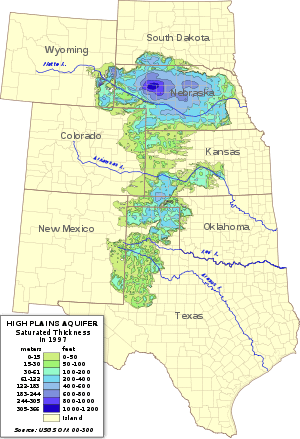The Ogallala Aquifer is a remarkable natural resource that lies under eight states in the high plains, including Kansas. The aquifer makes up an area of some 174,000 square miles in the heart of the country. The name comes from the underlying geologic strata that serves as an ideal subterranean catch basin for rain water that seeps into the ground.
“Crisis on the High Plains”, an article by Jeremy Frankel, and a CBS news report video provided our program.
The use of central pivot irrigation after World War II provided a great boost to agriculture in the region. Today the aquifer is the source of 27% of irrigation in the United States and provides drinking water for 2.3 million people. This remarkable resource is now in danger from agricultural chemical pollution and over extraction. The depth of the aquifer varies from 400 to 1,400 feet and every year the depth drops several feet due to overuse. The aquifer is recharged by annual rainfall that slowly seeps into the ground. Presently extraction far outpaces the rate of renewal. Agricultural chemicals have polluted portions of the aquifer. At the present rate, the aquifer will be depleted and unusable before the end of the century, creating an economic disaster.
Scientist believe that changes in agricultural practices and other conservation measures could extend the life of the Ogallala considerably. Some farmers have adopted dry land farming techniques that require less irrigation. Scientist and environmentalists call for a dramatic change in the culture of agriculture.
Farmers disagree about how best to address the problem. Some states have begun to implement regulations intended to reduce the depletion of the aquifer, but other states are taking a voluntary compliance policy with conservation measures. Time will tell if the Ogallala Aquifer can be saved.
